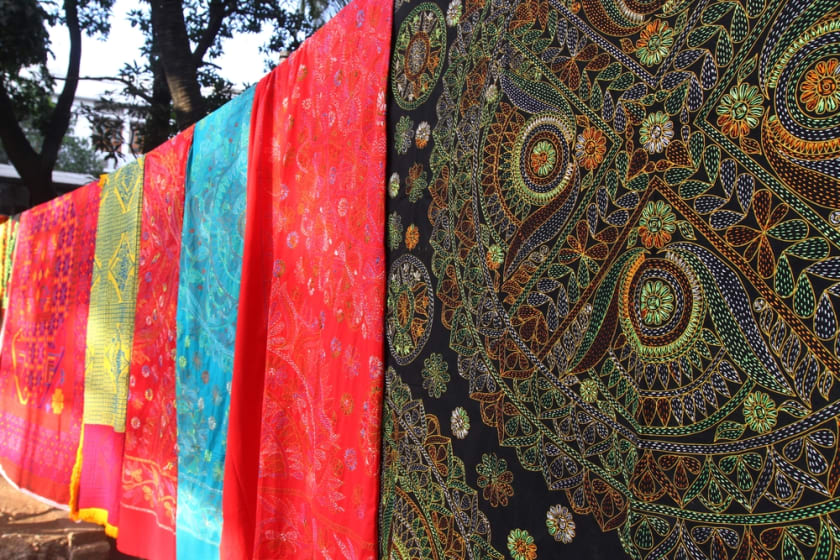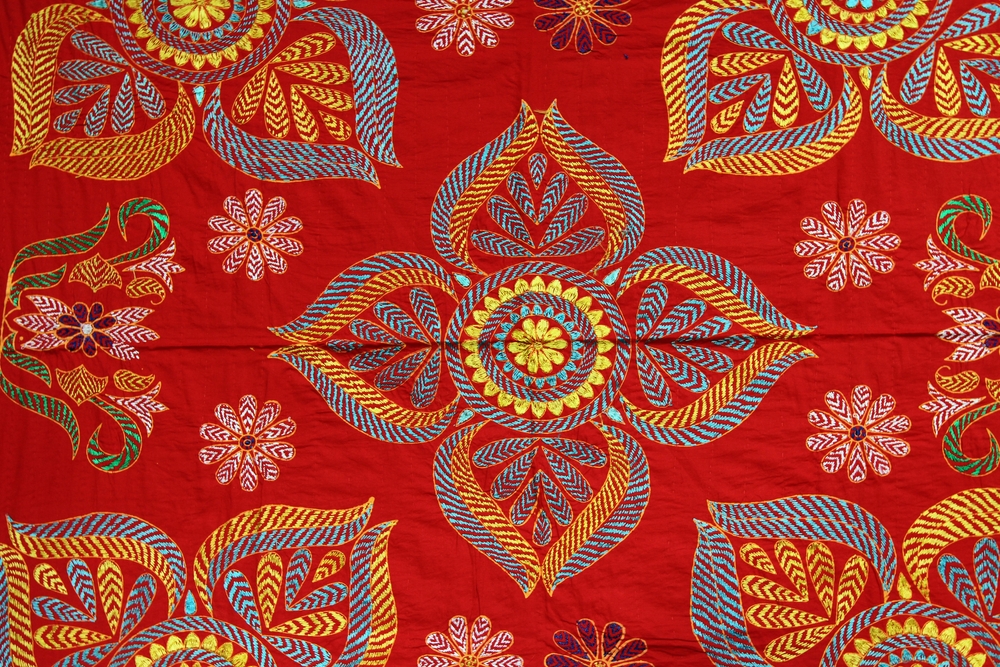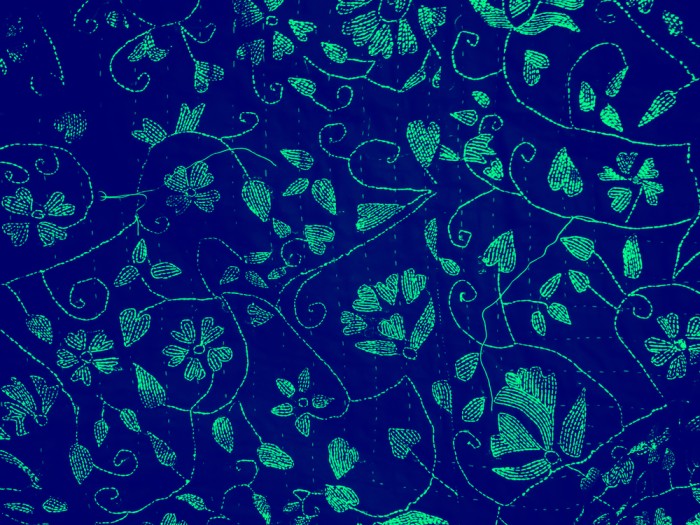In the Spotlight for Traditional Textiles: Nakshi Kantha



The art of Nakshi Kantha, one of the oldest forms of embroidery that hails from India, has origins that can be traced back to 1500 BCE or the pre-Vedic age. This delicate artwork is a form of traditional stitching of embroidery or patchwork on clothes made from rags. Women in the rural Bengal region, which is today’s East Indian states – Orissa, West Bengal and Bangladesh, started this form of embroidery.
The word Kantha refers to a finished cloth or a style of running stitch. The rural women of all classes practised this beautiful craft. In their leisure time, the wives of landlords, as well as the wives of farmers made their own Kantha, with skill and beauty. This practice was never ordered by kings or the landed gentry but instead has been passed down as a knowledgeable dowry from mother to daughter.
History of Nakshi Kantha
Nakshi Kantha has a historical significance in the world of textile and embroidery from India. This skilful craft is still practised by millions of Indian women who come from the rural villages of Bengal. Sadly during the 19th century, this form of art nearly disappeared until the daughter of the Bengali poet Rabindranath Tagore revived the form in the 1940s. During the year 1947, this art once again faded out during the war between India and eastern Pakistan. Finally, after the Bangladesh liberation war in 1971, this art form was revived again and stood its ground as a highly desired and valued art form.
Although the word Kantha does not have an etymological meaning, it is believed to be derived from the Sanskrit word Kontha, which translates to rags! The earliest written record of this art form dates more than 500 years ago. The poet, Krishna Das Kaviraj, has mentioned Kantha in the book Sri Chaitanya Charitha Amrita. In the book, he writes about how Chaitanya’s mother sends a homemade Kantha out of love for her son in Puri. The exact Kantha mentioned in the book is now on display at Sri Gambhira Temple in Puri.
Just like all the traditional textiles, Kantha was mainly influenced by various external factors like daily needs, material availability, and economic as well as the geography factors. Earlier, the production of textiles was one of the hardest and most labour intensive activities, which made textile a highly valued Item. The higher cost resulted in many people recycling well-used clothes as rags. As recycling textiles can be done in the comfort of the home, this work was taken up by the women of the houses. The women in the rural parts of the village cut the fabrics and stitch in the beautiful Kantha design, giving new life to the old textiles.
In the earlier stage, lungis, old cotton saris and dhotis, which were soft and worn out, were mostly used to make Kantha. Most of the time, the thread used for the embroidery was taken out from the fabric itself, making it a 360-degree use of the textile! It starts by layering 5 to 7 fabrics together, with the lighter coloured fabric on the outer side, so the pattern and stitch are easily seen. The stitch will cover the entire fabric, in order to increase its strength. A few times, the single piece of Kantha design was over generations, so the grandmother, mother and daughter end up working on the same fabric.
The Types of Stitches

Kantha generally refers to the unique type of stitch. The most basic and earliest type of Kantha stitch is a straight and simple running stitch. Over the years, a lot of elaborate patterns were introduced, known as Nakshi Kantha, which translates to artistic patterns. Most of these patterns are influenced by the culture, religion and the day-to-day lives of the rural women who stitch them. The hopes, dreams, personal lives, mythological characters, religious beliefs, folk stories, and ideas are beautifully sewn out of imagination to bring the art to life. Most of the designs consist of a lotus flower in the middle, along with fish, other flowers, plants and sceneries surrounding it to complete the look.
Another type of stitch is geometric patterns, which are made in proportion according to the Islamic tradition. The embroidery is done by looping the threads onto the surface, creating a running stitch to bring out a complex and beautiful geometric pattern.
In the northern region of Bangladesh, a unique stitch called the arnasi, or pineapple Kantha, is practised, whereas, in the Raj Shahi area of Bangladesh, a unique wine and floral pattern is practised.
The Kantha designs on carpets and cross stitches were introduced by the English during British rule in India.
Uses of Kanthas in Earlier Times
Kantha was traditionally used as a utilitarian or intimate item, which was made by hand over a long period of time just for the family. Traditionally, in the earlier days, every family in Bengal had a few items for personal use. It was used to cover the windows or doors during the winters or breezy monsoon.
Another use of Kantha fabric in the earlier times was for swaddling babies. Pregnant mothers mostly spent the last few months of their pregnancy practising this unique art of Kantha. By stitching it right at the time of birth and swaddling their babies in the fabric was believed to bring good fortune and protect the kids from any diseases. Few other versions of the designs were also created in smaller sizes to make purses, statues and floor covers for guests. They were also used as a cover for the Quran or even used as prayer mats.
How Is Nakshi Kantha Made?
At first, the ideas of the designs are crafted on a piece of paper, and once they are finalised they are transferred onto a tracing paper. The lines and designs are neatly drawn with a pencil! Just the process of designing and coming up with the ideas can take the artisans around 4 to 5 days.
A specially trained artisan will then prick tiny little holes along the design lines with a bamboo stick. The bamboo makes it easier to hold and create accurate holes throughout the design. This process takes almost a day.
The cloth or material used is then ironed neatly and cut into the respective sizes. The fabric is then laid onto a large table, with the tracing paper on top. Next, fabric dye is combined with turpentine to make a washable and smooth paste, which is rubbed across the tracing paper. The paste seeps through the tiny pinpricks onto the cloth, marking the design with tiny dots.
The fabric is then matched with different colours of threads that bring out the colour of the fabric to create the design. Using a simple needle tool and two anchor threads, a fine running stitch is made through the outline of the design, which is held tightly by an embroidery frame.
Few complex designs can even take months of work! So mostly, the clothes are given to the artisans to take to their home, so they can complete the design in their free time between caring for their family and household chores. Once done, they are washed by hand several times to remove the trace lines as well as dirt. The fabric is then ironed and ready to be designed into various apparel.
Nakshi Kantha in Today’s World

In today’s world, Kantha is still done by women in the rural villages of West Bengal, Gujarat, Bihar, Uttar Pradesh and South India! The delicate and intricate embroidery technique is carefully stitched by hand to create fashionable looking dupattas, saris and even dresses. Along with creating fashionable garments, the art of Kantha has made many rural women become financially independent, as well as being the major source of livelihood for their families. Many fashion houses and designer labels have incorporated Nakshi Kantha in various apparel like dresses and even overcoats. Some even come with a modern twist by using sustainable and handspun clothes.
Conclusion
Nakshi Kantha is a unique and traditional embroidery design that has made a huge leap in the fashion industry. Many textile labels have incorporated this design, pairing up with rural women and manufacturers to add a touch of Kantha in traditional as well as modern attire. Along with its traditional and unique design, Kanta is without any doubt sustainable! It is a way to upcycle and preserve something instead of discarding it, making it the best option in Indian textile!
Finding authentic and high-quality Kantha work to use for your fashion house or textile project can be a huge task, given the demand for this traditional embroidery design. Selecting an end to end manufacturing platform like Fashinza ensures that the business is supported with well-crafted designs by connecting them to leading manufacturers.



















